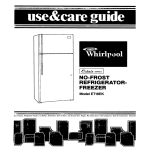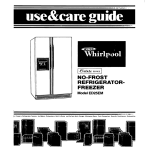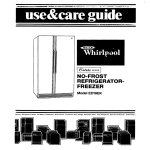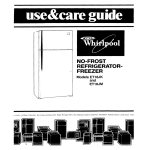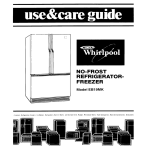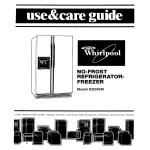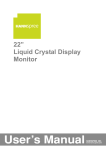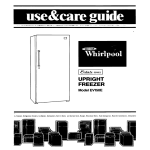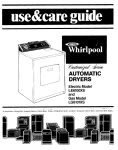Download Whirlpool ED25SMIII Specifications
Transcript
NO-FROST REFRIGERATORFREEZER 1 Model ED25SM :%?r%~w** Freezers, Refrlgeralor-freezers. * i&i*. ~WmI. ‘%Y’ .’ Ice Makers, Dishwashers, Bull-In Ovens and Surface Units, Ranges. Microwave Ovens. Trash Compactors, Room Air Condltloners. Dehumldlflc Please read this Use and Care Guide before you do anything else... This booklet tells you how to start your refrigerator, clean it, move shelves and adjust controls. It even tells you what new sounds to expect from your refrigerator. Treat your new refrigerator with care. Use it only to do what home refrigerators are designed to do. Parts and feature-s Ii\ I Ice Btn Shelves Meat Pan with Cold Control ‘Model Copy your Model and Serial Numbers and Serial Number Plate here... When you need service or call with a questlon. have this tnformatlon ready Model Number 1. Complete Model and Serial Numbers [from the plate located as shown). Serial Number 2. Purchase date from sales slip. Copy this InformatIon In these spaces Keep this book, your warranty and sales slop together in a handy place. 2 Purchase Date Service Company and Telephone Number -. -,. Contents BEFOREYOU PLUG ITIN Install Properly Level Refrigerator-Freezer Remove Sales Labels :: Clean It Plugltln USINGYOUR REFRIGERATOR Setting the Controls Power Saving Control Changing the Control Settings Adjusting Crisper Humidity Control Adjusting Meat Pan Temperature Adjusting Shelves Cold Water and Ice Dispenser Removrng Freezer Shelves Removing the Freezer Basket 3 4 4 4 4 4 5 5 5 5 6 6 6 6 8 8 Removing the Crrsper, Meat Pan and Covers Changing Light Bulbs Removing the Base Grille Sounds You May Hear Energy Savtng Tips CLEANING YOUR REFRIGERATOR ‘. ‘, Cleaning Chart FOOD STORAGE GUIDE :: Storing Fresh Food Freezing and Storing Frozen Food VACATION AND MOVING CARE IF YOU NEED SERVICE OR ASSISTANCE I, Before Calling for Assistance 2. If You Need Assistance 3. If You Need Service 4. If You Have a Problem --,- ----01983 Whirlpool “- -.-, 8 8 8 9 9 9 10 11 ,I1 12 15 16 -.. Corporation Before you plug it in IMPORTANT Before using your refrigerator, you are personally responsible for making sure that It... l is installed and leveled on a floor that WIII hold the weight, and in an area suitable for its size and use. l is connected only to the right kind of outlet, with the right electric supply and grounding. l is used only for jobs expected of home refrigerators. l is not near an oven. radiator or other heat source. is properly maintained. ISout of the weather. l is used in an area where the room temperature will not fall below 55’ F (13” C). l is not run where there are explosive fumes. l is not used by children or others who may not understand how tt should be used. . is not loaded with food before it has time to get properly cold. l l 3 Install properly.. . Remove sales labels.. . Remove the Consumer Buy Guide label and other rnstde labels before using the refrigerator Any glue left can be taken off with rubbing alcohol. -..ru~e~c-~-~~---~--~ Clean it.. . Clean your refrigerator before usrng It. See cleaning rnstructrons on page 9 I. Allow ‘/2” (.2 cm] space on each side and at top for ease of installation. 2. The refrigerator back can be flush against the WCIII. 3. If the refrigerator is to be against a wall, you might want to leave enough space so the door can be opened wider. e Screwdriver U-grounding plug t Refrigerator Power Cord Recommended Grounding Method Right to Raise; Left to lower 1. 2. 3. 4. 4 Remove base grille (see page 9 ). To raise front, turn each screw to the right To lower front. turn each screw to the left. Check with level. A 115 Volt, 60 Hz., AC only, 15 or 20 ampere fused electrical supply is required. It is recommended that a separate circuit serving only this appliance be provided. Do not use an extension cord. Use a receptacle which cannot be turned off wlth a switch or pull chain. See individual electrical requirements and grounding instruction sheet in your literature Using your refrigerator Temperature Control Air Control I / Air Outlet Power Saving Control The Temperature Control is in the refrigerator and the Air Control is in the freezer sectlon. When the refrigerator is plugged In for the first time 54@21 @ 3 1 Set theTEMPERATURE CONTROL to 3. The controls will be set about right when milk or juice IS OS cold as you llke and when ice cream IS firm. Do not block the air outlet on the control panel. Blocking it con slow the ar movement needed to keep temperatures at the level you set 234 2 Set the AIR CONTROL to 3 Power Saving Control.. . the Power Savlng Control on the Control Console operates electric heaters around the door openings. These heaters help keep moisture from formlng on the outside of the refrigerator. ,-, ... . ,../,.,L Changing . . the control ) \ 1 QUESTIONS? your COOL-LINE n service assistance telephone number (Pow 17). . ..Cdl .-. 1 Use the “OFF” seitlng when humidity ISlow .,..u- 2 Use the “0N”settlng if moisture forms on the outside of the refrigerator .. I. i **u._1 : .w,..r .; . .: settings... lf YOU need to adjust temperatures In the refrlgerator ,or freezer, use the settings llsted In the chorl below CONDITION: .“I._ ,I _. .I. If Refrigerator Section IS TOO .-I-.. WARM -. If Freezer Sectton IS TOO WARM Glve the retrlgerator time to cool down completely before addlng toad. (This may take several hours.] These settings should be about right for normal household retrlgerator usage. l l l Adjust the Temperature Control first. Wait at least 24 hours between adjustments. Then adjust the Air Control, if needed. ,.-- __._-..l_l-REASONS: ___ “~ ,.. -^..--- -.-,-.-_ Door opened often Large amount of food added Room too .-_ -- temperature ..-.- .__,-.-“-worm --. -.1.. “. . Door opened often Large amount of food added Very cold room temperature -...1-.--.-.-. -. Controls not set correctly ” foe your conditions -. ..If Refrigerator Section is TOO COLD .- ‘. If ICE isn’t MADE FAST ENOUGH - -.-....-“.-., ” . .-.._--_-,_s.. If BOTH SECTIONS ore TOO WARM He&y I& usage Very cold room temperature . ._, I - .II.^ - ... .. _ -_ Door opened often Large amount of food added Very worm or very cold ram temperatures _ -. RECOMMENDED SETTINGS: 4 Temperature Control 3 Atr Control .._ ..-.... ._.__ __.. .“,_ .._ ,,. 3 Temperature Control 4 Air Control T&f&&ature Air Control i 3 Control Temper&&Control Air Control _--_,__. .- ...__ __ . ._ Temperature Control Air Control 3 4 _, 3 2 5 Adjusting Humidity Adjusting crisper Control... Cold air flows against the meat pan through an opening between the freezer and the refrigerator This helps keep the meat pan colder than the rest of the refrigerator Set the control to let mofe or less cold air through You can control the amount of humidity In the mois ture-sealed crisper. The control can be adjusted to any setting be tween LO and HI LO (open) lets moist air out of crisper for best storage of fruits and vegetables with skins. HI [closed) keeps moist air In the crisper for best storage of fresh leafy vegetables. Adjusting meat pan temperature... Use Control to Adjust Meat Pan Temperatures shelves.. . Shelves can be adjusted to match the way you use your refrigerator. Glass shelves are strong enough to hold bottles. milk and other heavy food items. To remove door shelves: l Lift up and out To replace: Insert hooks into guides on both sides. l Push down. l To remove glass shelves: 1. Tilt up at front. 2. Ltft UD at back. 3 Pull shelf straight out G/ass shelves are heavy Be carefui To replace: 1 Guide the rear hooks Into the slots in the shelf supports 2. Tilt up front of shelf until hooks drop Into slot Lower front of shelf to level position i _ _a.---- Cold Water and Ice Dispenser... FOR ICE: Press a sturdy gloss ogolnst the Ice dispenser bar (Pressure and tumbling can break a fragile glass ) Remove the glass to stop dispensing The first few batches of Ice from the Ice maker may have o bad taste Throw them away This from new plumbing and parts FOR CHILLED WATER: Press o sturdy glass against the water dispenser bar (Pressure can break a fragile glass.) Remove the glass to stop dispensing. If the dispenser ISnot used regulorly. dispense enough every week to freshen the supply Allow 2-3 hours for chllllng. The small troy beneath the dispenser is designed to hold small spills. There is no drain in this troy Do not pour water into It. Water from small spills will evaporate. Ice Is dlspensed from the ice maker storage bin In the freezer When the dispenser bar is pressed, a trapdoor opens In a chute between the dispenser and the ice bin. Ice is moved from the bin and falls through the chute. When the dispenser bar is released. a faint buzzing sound may be heard for a few seconds. 6 Chllled water comes from a tank behind the meat pan. It holds about 50 ounces (1.5 L). When the refrigerator is first hooked up, press the water dtspenser with a glass or a jar until you have drawn and discarded 2 or 3 quarts (1.9 to 2.8 L). Only air will come out to start with. The water you draw and discard will rinse the tank and pipes. Allow about 24 hours to chill the first tankful III OFF/ON Slgnal Arti 2 Lift the stgnal arm so it clicks tnto the OF:F position. Ice can still be drspensed, but no more will be made. ,. .-. .,- 1. . .- ,,,, j,.. TIPS l The dispensers door closed. l l l l l ,. . . . will work only wrth the freezer The ice dispenser will work only if the btn IS pushed all the way In. Use only ice crescents trom the ice maker. Other shapes won’t dispense properly ’ When you need more ice than a glass or two. scoop It from the brn or remove the brn. The dispenser motor may stop if the dispenser bar is held In too long It will be ready to run again In about 3 minutes Ice stored too long can go stale Throw it away. .Irke water Ice can shrrnk. Cold moving air slowly evaporates them. If you use Ice often, you may never notrce the change. ._,,. ,~, Plan to remove and empty the storage bin: If the ice dispenser has not, or WIII not be used for a week or more; l If a power farlure causes ice in the bin to melt and freeze together, l If the Ice dispenser IS not used regularly. l 1 Pull the covering slide It to the rear. panel out from the bottom and 3. Lift the front of the storage bin. Pull It out. 4. Empty the bin Use hot or warm water to melt the ice if necessary Never use anythlng sharp to break up ice In the bin This can damage the brn and dispenser mechanism 5. Wash with mild detergent Rinse well.Do not use harsh or abrasive cleansers or solvents. 6 When replacing the bin, make sure it is pushed in all the way Push the signal arm down to the ON position to restart ice production. The nlght light uses a heavy-duty IO-watt bulb. It should last about 10,000 hours When It burns out. purchase another from your dealer. 7 -, Removing l l l freezer shelves. . . Changing light bulbs.. . Before removing a light shreld for cleaning or for replacing a bulb, unplug the refrigerator. Use op- Lift front sliahtlv. Lift back 05 supports Replace in reverse order. phmce bulbs only Lift the Front Then the Back Removing the freezer basket... For proper air movement, keep the freezer basket In place when the refrigerator IS operatrng To remove the basket: l Slrde out to the stop l Lift the front to clear the stop l Slrde out the rest of the way Pull on Pull Out at light bulbs behind refrigerate; and freezer control consoles: - Pull control knob straight off. - Pull bottom of control panel straight out. -Lift top of panel off supports. - Replace with a 40.watt appliance bulb. - Replace panel In reverse order. l light bulb behind ice maker: - Remove the Ice bin (see ice maker rnstructions page6). - Replace with a 40.watt appliance bulb. -Replace Ice bin l Dispenser light: - Reach the bulb through the dispenser area. - Replace with a heavy-duty IO-watt bulb. To replace % the basket: l Place basket on the slrdes l Make sure the wrre stops clear the front of theslrdes l Slide basket tn ~I. I.sEx_..r. NJ*L ‘.._/ “.5,..I~.~U,S, ? :,~.a,&” c**,>Tiii*e.az,_.rlL Removing the crisper, and covers.. . l l l l meat pan a.<,.. **“WY-,- e*- Removing l ,, 1 r,-..*..LY,-.a.l~-.Jes.~.~.T -5 the base grille... Open the doors Slrde crisper and meat pan straight out to stop Lrft the front. Slide the rest of the way out Replace in reverse order. Push the lab to Clear the Cover. l l Pull grille outwards as shown Do not remove Tech sheet fastened behind grille. Snap Back into Place. l Covers are held In place by two pegs at the back and two notched tabs In front - Press front tabs out of the way -Lift cover front. -Lift back off the pegs - Replace in reverse order To replace: Line up grille support tabs with metal clips. l Push firmly to snap into place l Close the doors. l Sounds you may hear.. . Your new refrigerator may make sounds that your old one didn’t Because the sounds are new to you. you might be concerned about them Don’t be Most of the new sounds are normal. Hard surfaces like the floor, walls and cabinets can make the sounds seem louder. The followlng chart describes the kinds of sounds that might be new to you, and what may be making them ._.. Porslble- So&&: l Slight Hum, Soft Hiss: Clicking Sounds: l or Snapping Probable Causes: Your refrigeratcr has two fans; you may hear the fan motors and moving atr. The defrost timer makes a definite click when the refrigerator also makes a sound when the refrigerator starts. stops running It l Water Sounds. When the refrigerator stops running, you may hear gurgling In the tubing for a few minutes after It stops. You may also hear defrost water running into the defrost water pan l Ice Maker You &aY hear a buzzing [from the water valve), trickling water and the clatter of ice dumped into the bin. l Running Sounds: Sounds: Your refrigerator has a high-efficiency compressor and motor. It will run longer than older designs. It may even seem to run most of the time Energy saving tips.. . You can help your refrigerator use less electricity Check door gaskets for a tight seal. Level the cabinet to be sure of a good seal. l Clean the condenser coil regularly l Open the door as few times as possible Think about what you need before you open the door Get everything out at one time. Keep foods organized so you won’t have to search for what you want. Close door as soon as food is removed l Go ahead and fill up the refrigerator, but don’t overcrowd It so air movement IS blocked l l Cleaning ., ,_. ;1your *, 1,refrigerator.. :, Both the refrigerator and freezer sections defrost automatically But both should be cleaned about once a month to help prevent odors from bulldIng up. Of course, spills should be wiped up right away l l It is a waste of electricity to set the refrigerator and freezer to temperatures colder than they need to be. If ice cream IS firm in the freezer and drinks are as cold as your family likes them, that’s cold enough. Keep the Power Saving Control on OFF unless moisture forms on the refrigerator exterior. Make sure your refrigerator is not next to a heat source such as a range, water heater. furnace. radiator, or in direct sunlight. . To clean your refrigerator, turn the Temperature Control to OFF, unplug It. take out all removable parts, and clean It according to the following directions Cleaning Chart;. . _, ._-. _. What to .._.use ,....._ Mild detergent and warm water . Part Removable parts (shelves, crisper, meat pan etc.) _Sponge, cloth or paper towel; mild detergent; appliance wax (or good auto paste wax). Outside How to clean l l l l l .~. ., Inside walls (Freezer should be allowed to warm up so cloth won’t stick.) Door liners and gaskets surfaces provides rust _ 1protectlon. ,__-._ “.._ .. . -_I..-..--“.-_.-.-.^-I_l Wash with warm water and -mild detergent or -baking soda (2 tablespoons [26 gl to 1 quart [ .95 I] warm water dry. .. . .. _il Rinse .~ . and. .__._” .._..- _;,_. .._ .~ l Wash with mild detergent and warm water l Rinse and dry DO NOT USE Cleaning waxes, concentrated detergents, bleaches or cleansers containins_petroleum plastic parts. -“I_.-_..” I _.- .--.-,1.---.- I---.. ., .II. -.. “___“.. ,_. on r_.-_..I--_.---,...P^--” l Wash with a soft grit-free cloth or Mild detergent and sponge. warm water; soft, clean l Rinse and dry with a damp grit-free sponge and soft, clean cloth or chamois. cloth. Dark panels 1. metal *Waxlng ,,...‘ _-_ palnted ._-_,___------.-Sponge, soft cloth or paper towel, baking soda, warm water, mild detergent. _ ,___^_, Sponge, soft cloth or paper towel; mild detergent, warm water. -. Warm water and mild detergent. l l l l l l l Condenser . .~ Coil _ I. Floor under refrigerator 10 _,_._ DO NOT USE paper towels, window sprays, scouring cleansers, or solvents like acetone, benzine, carbon tetrachloride, etc. These can .-.scratch or damage 1-the_, material. *_ ._.,. ._ ..-_----__1_.-*.*_;.~__. j_l._., .._. _ _ ..__” Defrost pan .” _, ,... “..._” ..-. Wash removable parts with warm water and a mild detergent. Rinse and dry. _, Wash with warm water and a mild detergent. Do not use abmrlve or harsh cleansers. Rinse and dry Wax painted metal surfaces at least twice a year with appliance wax or a good auto paste wax. Apply wax with a clean, soft cloth. Do not use wax on plasttc parts. _.,.. Vacuum cleaner; using the extended narrow attachment. ” j. ,, , ,, Usual floor cleaners. l Remove base grille. [See page 8.1 To remove defrost pan, lift pan over wire brace [remove tape; if any). Wash defrost pan with warm water and mild detergent. Rinse and dry Replace with notched corner to the rear Push it all the way in Make sure defrost drain tube is pointing into pan. Replace .- .I L .-base grille. Remove base grille. Clean dust and lint from condenser at least every other month. Replace.^-;base r. .._., ~l _.__-, -_ grille.. _ _ l Roll refrigerator out only as far as water supply line allows. l Wash floor. l Roll refrigerator back. l Check to see if the refrigerator is level. l l .I Food storage guide STORING FRESH FOOD Cured or Smoked Meat and Cold Cuts. Ham, bacon, sausage, cold cuts, etc keep best in original wrappings Once opened, tightly re-wrap In plastic wrap or aluminum foil Canned Ham. Store In refrigerator unless the label says It’s okay to store on the shelf Do not freeze Fresh Poultry Loosely wrap in waxed paper or plastic wrap The plastic wrap on poultry as purchased, may be used for storage STORAGECHARTFOR FRESHAN0 CUREDMEAT7 We There IS a right way to package and store refrlgerated or frozen foods To keep foods fresher, longer. take the time to study these recommended steps Leafy Vegetables. .Remove store wrapping Trim OT tear off bruised and discolored areas Wash In cool water. drain and store In crisper Cold, moist air helps keep leafy vegetables fresh and crisp. The crisper has sealing gaskets to help keep humid air In. It also has a control to help adjust the amount of humidliy in the crisper Vegetables with Skins [carrots, peppers] Store In crisper, plastic bags or plastic container Wash, let dry and store In refrigerator In Fruits plastic bags or crisper Do not wash or hull berries until they are ready to use Sort and keep berries in their store container in a crisper, or store in a IOOselv closed paper bag on a refrigerator shelf Meat. Meat IS perishable and expensive you won’t want to waste an ounce of It through careless handling The followtng list and chart give you packaging hints and time limits Store meat in the meat pan Fresh, Prepackaged Meat. Store fresh meat in the store wrapping Vacuum packaged meat con be frozen for as long as one month If the seal IS not broken If you want to keep It frozen longer, you should wrap It with special freezer wrapplng material Fresh Meat, Not Prepackaged. Remove the market wrapping paper and re-wrap loosely In waxed paper or aluminum foil for storing It unfrozen Cooked Meat. Wrap or cover cooked meat with waxed paper, plastic wrap or aluminum to11 Store Immediately Approxlmato ww Varlety Meats . . . . . . . . . . , . . . . . . . Chicken .......... ............... Ground Beet . . . . . . . . . . . . . . . . . . Steaks and Roasts . . . . . . . . . . . . . Cured Meats . . . . . . . . . . . . . . . . . . . . . Bacon . . . . . . . . . . . . . . . . . . . . . . . . . . . . Cold Cuts . . . . . , . . . . . . . . . , . . . , . . . . lime 1 to 2 1 to2 1 to 2 3 to 5 7 to10 St07 3 to5 *If meat is to be stored longer than the times given. follow the directions for freezing. NOTE: Fresh fish and shellflsh should be used the same day as purchased Store without washing in the original carEws ton or use the Utlllty Bin that came with your refrigerator. Milk Wipe milk cartons For best storage, PloCe milk on lnterlor shelf or bottom door shelf Beverages Wipe bottles and cans Store on a door shelf or inside the refrigerator Butter.. .Keep opened butter In covered dish or in the Utlllty Compartment. When stoclng an extra Supply, wrap In freezer packaging and freeze Store In the orIginal wrapping until Cheese you are ready to use It Once opened, re-wrap tightly in plastic wrap or aluminum loll Store small jars and bottles (catCondiments sup, mustard, jelly, olives] on the door shelves where they are In easy reach leftovers Cover leftovers with plastic wrap or aluminum fotl to keep food from drying out and transferrlng food odors Plastic containers with tight lids are fine. too REEZING & STORING FROZEN OODS 6 3 The freezer sectron ISdesrgned for storage of comnercially frozen foods and for freezing foods at lome. Packaglng-The secret of successful freezing IS 1 the packagrng. The wrap you use must be air, norsture and vapor proof. The way you close and eal the package must not allow arr, morsture or apors in or out. Rrgrd polyethylene (plastic] containers with trghtltting lids. straight-srded canning/freezing jars. leavy-duty aluminum foil, plastic-coated paper and ronpermeable plastic wraps [such as Saran) are ecommended. Note: Heat-sealed bowling bags are ?asy to use and can be used by themselves or as :arton liners. Sealing - When sealrng foods In bags squeeze But the air (Irquids need headspace to allow for ?xpansron.) Twist the top and turn It back Fasten tie securely around the doubled-over tall. Put the label nside transparent bags, use self-adhesive label on outside of opaque ones Air-tight wrapplng calls for “drugstore” wrap. Cut the sheet about one-third longer than the distance around the food Bring the ends together and fold in (toward the food) at least twice to seal out air. Crease ends close to food, press air from package Fold tips over twrce. Frnrsh package and tape closed. NOTE With unboned meats, pad sharp edges with extra wrap or use stockrnette to protect the wrap from punctures DO NOT USE Bread wrappers l Non-polyethylene plastic containers l Contarners without trght lids l Waxed paper l Wax-coated freezer wrap l Thin. semt-permeable wrap None of these are totally moisture. air or vapor proof. l Freezing Frultr - Select ripe, blemish-free fruits Be sure they taste as good as they look Wash 2 to 3 quarts (liters) at a time and drain. Fruit that stands rn water may lose food value and become, soggy. Sort, peel, trim, prt and sltce as needed. Pack in rrgrd wide-mouthed containers or other recommended material. Leave head space to allow liquids to expand during freezing. Freezing Vegetables - Freeze only fresh highquality vegetables picked when barely mature. For best results, freeze no more than 2 to 3 hours after picking. Wash in cold water, sort and cut into appropriate srz’es. Blanch or scald. Pack in recommended container and freeze Do not freeze lettuce, celery. carrot sticks. potatoes or fresh tomatoes. All WII! become limp or mushy. Tomatoes WIII collapse when thawed Freezing Cooked Food-Prepare cooked foods as you would for the table; shorten cooklng time10 to 15 minutes to allow for additional cooking during reheating Omit seasonings and part of the Irqurd. Plan to add them at reheating time. Potatoes should also. be added to soup and stew at heating time Add crumb and cheese topptngs at heating trme. Cool as rapidly as possrble and freeze at once. Liquid or semr-liquid dishes may be frozen In recommended containers with head-space Casseroles and other more solid foods may be frozen in the baking container. If you don’t want to leave your casserole dish in the freezer, line it with forl. Bake, cool, freeze, lift out the for package, bag it and return to freezer. Freezing Meats -The meat you thaw can only be as good as the meat you freeze “Drugstore” wrap In meal-size packages Flat cuts or patttes should be wrapped indrvidually or in layers separated by a double thrckness of freezer wrap. Make sure store wrappings are moisture and vapor proof. If not, re-wrap meats with one of the wraps recommended under “Packaging” Freezing Baked Goods -Wrap baked breads In recommended material. Thaw In wrapping. Unbaked yeast breads can be frozen after the ftrst ristng. Punch down, wrap and freeze Bake cookies as usual. Cool and freeze on trays. then pack in recommended freezer bags or cartons. Unbaked cookres may be dropped, molded or rolled and frozen on cookre trays Store in bag or carton, bake without thawrng. Refrigerator-type cookres can be wrapped and frozen in roll form. Thaw only enough to slice when ready to bake. Fruit pies are best frozen unbaked. Bake without thawrng. Bake pecan and srmrlar pies before freezing ..rrch fillings do not freeze solid. Cut steam vents in top crusts when ready to bake IMPORTANT: Do not expect your freezer to quick-freeze any large quantity of food. Put no more unfrozen food into the freezer than will freeze within 24 hours. (No more than 2 to 3 pounds of fresh meat or 3 to 4 pounds of vegetables per cubic foot of freezer space.) leave enough space for air to circulate around packages. Be careful to leave enough room at the front so the door can close tightly. FOOOSTORAGECHART Storage times* will vary according to the quality of the food, the type of packaging or wrap used (moisture and vapoc-proof). and the storage temperature which should be 0” F ( -17.&C]. Storage tlmo FRUtTS Fruit juice concentrate . . . . . 12 months Commercially frozen fruit . . 12 months Citrus fruit and juices.. . . 4 to 6 months Others . . . . . . . . . . . . . . . . . 8 to 12 months VEGETABLES Commercially frozen . . . . . . . 8 months Home frozen . . . . . . . . . . . 8 to 12 months MEAT Bacon . . . . . . . . . . . . . . 4 weeks or less Corned beef . . . . . . . . . . . . . . . . . 2 weeks Cured ham . . . . . . . . . . . . 1 to 2 months (Salting meat shortens freezer Ilfe) frankturters . . . . . . . . . . . . , . . . . . 1 month Ground beef, lamb, veal 2 to 3 months Roarts: Beet . . . . . . . :. . . . . . . . . 6 to12 months Lamb and veal . . . . . . 6 to 9 monYhs Pork . . . . . . . . . . . . . . . . . . 4 to8months SausogeJresh . . . . . . . 1 to 2 months Steaks and chops: Beef . . . . . . . . . . . . 8 to 12 months Lamb. veal, pork . . . . . . 3 to 4 months FISH n Cod, ilounder, haddock Sole.. . . . . . . . . . . . . . . . . . . 6 months Blue fish, salmon . . . . 2 to 3 months Mackerel. perch . . . . . . . . 2 to 3 months Bread&U tlsh (purchased) . . . 3 months Ckma. oysters, cooked flsti, crab, scallops . . . . 3 to4 months . . . . . . . . . 10 months Alaskan king crab Stiiimp,uncooked . . . . . . . . . 12 months POULTRY Whele Chlcken or turkey . . . 12 months Duck . . . . . . . . . . . . . . . . . . . . . . . . 6-months Giblets . . . . . . . . . . . . . . . . . 2 to 3 months Cooked poultry w/gravy , , , 6 months Slices (no gravy) . . . . . . . . . . 1 month Storagotlme Food MAIN DISHES Stews; meat, poultry and fish casserote . . . . 2 to 3 months TV dinners.. . . . . . . . . . . . . . 3.to 6 months DAIRY PRCDUCTS Butter . , . . . . . . . . . . . . . . . .‘I 6 to 9 months Margarine , . . . . . . . . . . . . . 2 to 9 months Cheese: Camembert, brick, ‘.’ Mozzarella, farmer’s . :. . 3 months Creamed cottage . . DC NOT FREEZE. Cheddar, Edarn,~Goucta, Swiss, etc.. . . . . , . . . . . . 6 to8 weeks Freezlng can changetexture of cheese. Ice cream, ice milk sherbet..................... 4weeks EGGS Whole (mixed) . . . . . . . . . 9 to 12 months. Whltes . . . . . . . . . . . . . . . . . 9 to 12 months Yolks . . . . . . . . . . . . . . . . . . . 9 to12 months [Add sugar or salt to yolks or whole mixed %KJsl BAKEDGGUDS Yeast breads and rolls . . , . . . 3 months Baked Brown ‘N Serve rolls . . . . . . . . . . . . . . . . . . . . . . 3 months Unbaked breads.. . . . . . . . . . . 1 month Quick breads . . . . . . . . . . . 2 to 3 months Cakes, ungosted .“. . . . . . . 2 to4 months Cakes, frosted . . . . . . . .‘: 8 to 12 months Fruit cakes . . . . . . . . . . . . . . . . . 12 months Cookie dough . . . . . . . . . . . . . . 3 months Bakedc@okles . . . . . . . . . 8 kl2months Bakedtier . . . . . ;...‘...... 1toPmonths Pledoughonty . . . . . . . . . . 4to6months ‘Based an U.S.DA and MChQan staroge Imes Coo~etahve Erlens~cnService suggested If electricity goes off Call the power company Ask how long power WI/I be off 1. If service IS to be Interrupted 24 hours or less. keep both doors ciosed This WIII help frozen focds to stay frozen 2. If service IS to be Interrupted longer than 24 hours [a] Remove all frozen food and store in a frozen food locker Or (b) Place about 20 pounds of dry ice on top of the food, using pieces as large as possible Protect your hands wrth gloves [c) If neither food locker storage nor dry ice IS available, use or can perishable food at once 3. A full freezer will stay cold longer than a partly fIlled one A freezer full of meat will stay cold longer than a freezer full of baked goods If food contarns Ice crystals, It may be safely refrozen, although the quality and flavor may be affected Use refrozen foods quickly If the condition of the food IS poor or you have any suspicions. It IS wise to dispose of It Vacation and movi care - Short vacations. .. Moving... No need to shut off the refrigerator If you WIII be away for less than four weeks. Use up perishables; freeze other items. Turn off your ice maker; shut off the water supply; empty the ice bin and make sure all ice cubes are dispensed out of the mechanism. Long vacations. .. Remove all the food if you are going for a month or more. At least a day ahead, turn off the water supply to the ice maker. When the last load of ice drops, turn off the ice maker. Unplug the refrigerator and clean it...rinse well and dry. Tape rubber or wood blocks to both doors ...keeping them open far enough for air to get in. This will keep odor and mold from buildina UD. Tape the blocks out d a child’s reach...do allow children near the refrigerator when doors are blocked open. To restart refrigerator, not the see “Using Your Refrigerator.” Shut off the ice maker water supply a day ahead of time. Disconnect the water line, After the last supply of ice drops, turn off the ice maker. Remove all food. Pack frozen foods in dry ice. Unplug the refrigerator and clean it thoroughly. Remove everything that comes out. Wrap all parts well and tape them together sothey don’t shift and rattle. Also, remove the water supply tank behind the meat pan by: 1. Disconnecting water inlet and outlet tubes at the top of the tank. 2. Removing three mounting screws from the tank. 3. Draining the tank. Re-Install the empty tank, and remember to check for tight water connections when the refrigerator is hooked up at your new location. Screw in the levelling rollers; tape the doors shut; tape the electrrc cord to the cabinet. When you get to your new home, put everything back, and refer to page 4. Don’t forget to reconnect the water supply line QUESTIONS? .call your COOL-LINE” service assistance telephone number (page171 15 If you need service or assistance, we suggest you follow these four steps: 1. Before calling for assistance.. . Performance problems often result from little things you can find and fix yourself without tools of any kind If your refrigerator l Is the electric will not operate: cord plugged If your ice maker will not operate: l Has the freezer had enough ttme to get cold? With a new refrigerator, this might take overnight l Is the signal arm ON. In the down positIon l Is the water valve turned on7 Is water getting to the Ice maker7 In’J If there Is water in the defrost pan: In hot, muggy weather, this IS normal The pan can even be half full Make sure the refrigerator IS level so the pan doesn’t overflow If the lights aren’t working: l Check fuses and circuit breakers Make sure it’s plugged in If a bulb is burned out: l See Instructions for changing light bulbs on page 8. Use appliance bulbs only If the motor seems to run too much: l Is the condenser, behind the base grille. free of dust and lint? l On hot days, or if the room IS warm, the motor naturally runs longer l If the door has been opened a lot, or if a large amount of food has been put in. the motor will run longer to cool down the interior l Is a fuse blown or a circuit breaker tripped? Is the Temperature Control turned ON? If there Is a rattling or jlngllng nolse, or other unfamlllar sounds: l Is something on top or behind the refrigerator making noise when the refrigerator is running? l New features on your new refrigerator make new sounds. You may be hearing air flowing from the fans, timer clicks for the defrosting cycle, defrost water draining into the defrost pan l l 16 Remember: Motor running time depends on different things, number of doot openings. amount of food stored, temperature of the room, setting of the controls. And, your new refrigerator may be larger than your old one so it has more space to be cooled It also has a regular freezer Instead of a frozen food compartment. All this means better refrigeration and may require more running time than your old one 2. If you need assistance*... 4. If you have a problem*... Call Whirlpool COOL-LINE@ service assirtance telephone number. Dlal free from: ContInental U.S. . . . . . . . . . . . . (800) 253-1301 Mlchlgan . . . . . . . . . . . . . . . . . . . (800) 632-2243 Alaska 6 Hawall . . . . . . . . . . . (800) 253-1121 and talk with one of our trained Consultants. The Consultant can instruct you in how to obtain satisfactory operation from your appliance or, if service is necessary. recommend a qualified service company in your area. 3. lf you need service*. Call our COOL-LINE service assistance telephone number (see Step 2) and talk with one of our COWItants, or if you prefer, write to: Mr. Guy Turner, Vice President Whirlpool Corporation Administrative Center 2000 US-33 North Benton Harbor, Ml 49022 *If you must call or write, please provide; model number, serial number, date of purchase. and a complete description of the problem. This information is needed in order to better respond to your request for assistance. 0 FSP 63 FSP IS a registered trademark of Whirlpool Corporation for quality park Look for this symbol of quality whenever you need a replacement pari for your Whirlpool applrance. FSP replacement parts will fit right and work right. because they are made to the same exacting specifications used to build every new Whirlpool appliance .. Whirlpool has a nationwide network of franchised TECH-CAREm Service Companies. TECH-CARE service technicians are trained to fulfill the product warranty and provide after-warranty service, 1 FRANCHlSED SERVICE I anywhere in the United States. To locate TECH-CARE service in your area, call our COOL-LINE service assistance telephone number [see Step 2) or look in your telephone directory Yellow Pages under: 1 APPLIANCES-HOUSEHOLDMAJOR-SERVICE 6 REPAIR WHIRLPOOLAPPLIANCES FRANCHISEDTECH-CARESERVICE SERVICE XYZSERVICECO 123 Maple ELECTRICAL APPLIANCESMAJOR-REPAIRING 6 PARTS OR COMPANIES WHIRLPOOLAPPLIANCES FRANCHlSEDTECH.CARESERVlCE SERVICE XYZSERVICECO 123 Maple 999-9999 COMPANIES 999.9999 OR WASHING MACHINES, 6 IRONERS-SERVICING DRYERS WHIRLPOOLAPPLIANCES FRANCHISEDTECH-CARESERVICE SERVICE XVZSERVICECO 123 Maple COMPANIES 999.9999 17 Notes 18 Notes 19 II Making your world a little easier. Part No. 944017 Rev. B 01983 Whirlpool Corporation Printed in U.S.A. : Makers. Dishwashers. Bu~ll-In Ovens and Surface Units, Ranges, Microwave Ovens. Trash Compactors, Room Au Conditioners, Oehumldlflers, Automatic Washers, Clolhes Or




















